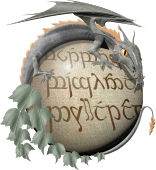- Cities and buildings
- Fields, plains and deserts
- Forests
- Hills and mountains
- Islands and promontories
- Lands, realms and regions
- Rivers and lakes
- Seas and oceans


 |
||||
|


Which personality type are you?
Take the Free mydiscprofile Personality Test to discover your core personality and your ideal job.   Which personality type are you? |
|
Dates
Origins
Race
Part of a writing system devised by the Elves
Pronunciation
loo'va
Meaning
'Bow'1
|
LúvaThe ‘bow’ of the Fëanorian charactersEach of the twenty-four standard Fëanorian tengwar of the Elvish alphabet was composed of two basic elements: a straight telco or stem, from which curved a rounded 'bow' shape known as a lúva. The nature of the bow defined the téma, or sound-series, to which a character belonged. Some curved upwards and leftwards from the stem, while others curved downwards and to the right. The lúva was sometimes 'closed' (with a horizontal bar connecting it back to the telco) or sometimes left 'open'. For instance (using the conventions of the Third Age) all the tengwar with an open lúva curving down and right belonged to the tincotéma, the series of 't' sounds, while all those with a closed, upward, left-curling lúva were part of the calmatéma (sounds related to 'k'). Though the direction and structure of the lúva was always constant within a series, it was often 'doubled' within that series (that is, a second bow would be drawn curving out from the first). For instance, the character tinco ('t') had a single lúva, while the 'voiced' version of the same sound, ando ('d') had a double bow. Notes
For acknowledgements and references, see the Disclaimer & Bibliography page. Original content © copyright Mark Fisher 2005, 2021. All rights reserved. For conditions of reuse, see the Site FAQ. Website services kindly sponsored by Discus from Axiom Software Ltd.Candidate experience is key. The Discus personality test works across every browser and operating system. |